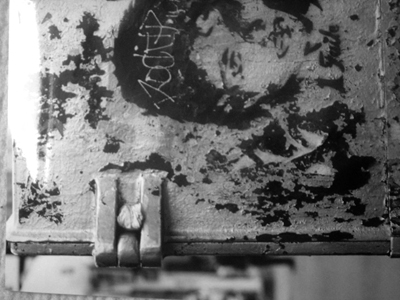The Vagracy of Uncertainty
by Colette Meacher
‘I no longer wish to refrain from the errors of my fingers, the errors of my eyes. I know now that these errors are not just booby traps but curious paths leading towards a destination that they alone can reveal to me. There are strange flowers of reason to match each error of the senses. Admirable gardens of absurd beliefs, forebodings, obsessions and frenzies… How long shall I retain this sense of the marvellous suffusing everyday existence? I see it fade away in every man who advances into his own life as though along an always smoother road… who rids himself progressively of the taste and texture of the unwonted, the unthought of. To my great despair, this is what I shall never know.’ (Louis Aragon)
Today’s psychogeographical adventures have a long historical
lineage, with threads leading off both to diverse cultures and to different
historical periods. To unravel this chain of association would require many
words on lots of pages, by which time you might well be simply ‘beginning
to feel the disgust for words that comes from taking no exercise’, as
Bruce Chatwin found himself to be after sitting around for too long reading
books and simply thinking about walking.
So rather than risk boring or disgusting you, I’ll take you on a quick
saunter around the block and tell you a little about how the notions of failure
and error have been central to this history. I may be wrong, but it seems
to me that messing it up, or losing one’s drift has been both crucial
and necessary to the urban wanderer, as well as also being the means to insights
of a sublime, marvellous or surreal kind for those inclined to see them. This
was self-evident to walking writers in the eighteenth century, but by the
start of the twentieth century, the idea became all-important to Dada and
then to Surrealist painters, poets and writers, reflecting as it did everything
that was indeed wrong in inter-war Europe.
The Romantics of the late eighteenth century were the first to walk the city
in a self-conscious way and as an aesthetic act. Their urban equivalent, the
flâneur, was quick to follow in their footsteps. The flâneur,
narrowly defined, was a product of modernism – and all the benefits
that the Industrial Revolution created – gas, sewage system, electricity,
paving etc. – which opened the city as a space which could be experienced
on foot. The flâneur, however, as distinct from the mere minions scurrying
to and fro from work, was a financially independent bourgeois dandy who possessed
the time, wherewithal and artistic inclination to wander the streets of the
urban metropolis randomly and at will – blithely playing with the myriad
images that the city constantly throws up.
The flâneur was a somewhat melancholic figure displaced by the radical overhaul of Paris under the architect Hausmann. He (for the flâneur was usually male) was depicted as a failed artist by Balzac, Flaubert, Zola and Huysmans in the latter half of the century, whose creativity was destroyed by excessive immersion in the city’s delights. The demise of this popular figure was triggered by what he perceived to be a failing of the city itself; the flâneur’s carousing around his much-loved arcades came to an end with their replacement by built-up shopping complexes, which limited his freedom to roam, observe and muse at will.
But the flâneur essentially failed himself; having been consumed by his passion for the city and having over-indulged in prostitution, consumerism, drugs and alcohol, his only option was to seek refuge in the walls of his home. He became ever-increasingly immersed in aesthetic decisions and judgements of taste about wallpaper, carpets and the benefits of a well-stocked drinks cabinet rather than the minutiae of street-life. The flâneur came to embody failure as such, washed up as a melancholic and socially isolated figure, marginalised on the fringes of society, without personal relations, work or belief, absorbed by the hubris of a lost sense of self.
For Dada artists (1916-1922), this loner-flaneur became a huge source of inspiration. Rather than endeavouring to recuperate the wounded image of this romantic anti-hero, they played precisely on his failings as starting point for their own ridiculous gestures, actions and manifestos. The flaneur’s jewel-encrusted walking stick became a beater to chase recumbent aesthetic ideas out of hiding, to ruffle the tail-feathers of the cultural and political bourgeoisie who were using the lofty notions of high romanticism to ill-effect in the name of fascism.
In April 1922, the Dadaists organised a series of guided walks around Paris to demystify emotionally dead sites of supposed cultural significance. However, the first excursion was to be the last as it had been such a resounding success; in other words, a complete failure. Their walk to the church of St. Julian le Pauvre, aptly conducted on a day of incessant rain, attracted not one single participant. Hardly surprising, reading the bad press they themselves gave the event… “The Dadaists… wishing to remedy the incompetence of guides… have decided to undertake a series of visits to chosen places, particularly those that have really no reason to exist”, announced the poster. “Wash your breasts as you wash your gloves”, they suggested. “Property is the Luxury of the Poor, Be Dirty”…
Failure was the raison d’être of their project, failure that was written into its brief both implicitly and explicitly. The public was no doubt baffled by an invitation which seemed to deny their participation, which contained both incitement and negation. For if a place ‘really has no reason to exist’, why would anyone choose to visit it? Yet the Dadaists had done no wrong: -
Pandemonium, destruction, anarchy, anti-everything – why should we hold it in check? What of the pandemonium, destruction, anarchy, anti-everything, of the World War? … In return to freely exposing ourselves to ridicule every day, we surely had the right to call the bourgeois a bulging haybag and the public a stall of oxen? We would have nothing more to do with the sort of human or inhuman being who used reason as a juggernaut, crushing acres of corpses – as well as ourselves – beneath its wheels.
(continued here)

